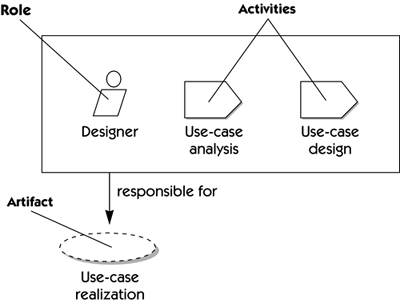The Structure of the Rational Unified Process 1
The Structure of the Rational Unified Process [1]
A process describes who is doing what, how, and when . The Rational Unified Process is described using four key modeling elements (Figure E-1):
Figure E-1. Roles, activities, and artifacts A role defines the behavior and responsibilities of an individual or a group of individuals working together as a team. The behavior is expressed in terms of activities the worker performs , and each worker is associated with a set of cohesive activities. The responsibilities of each worker are expressed in relation to certain artifacts , or work products, that the worker creates, modifies, or controls. Disciplines allow the grouping of activities into meaningful sets that provide some result for the development organization and show how various workers interact. Beyond these four main concepts, the Rational Unified Process introduces specific techniques in the form of guidelines mapped to activities, templates for major artifacts, and tool mentors , that is, guidance on how to proceed using software development tools. |
EAN: N/A
Pages: 257
